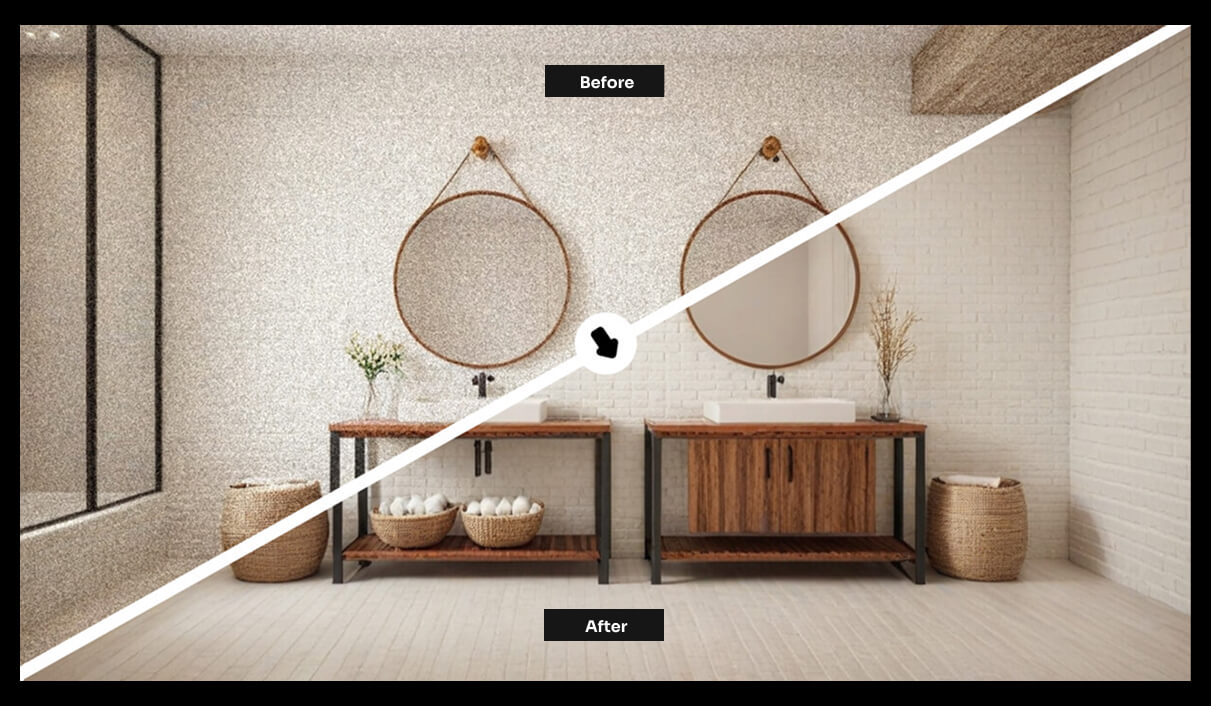This quick guide will equip you with everything you need to know to get the most out of MyArchitectAI.
First of all, MyArchitectAI is made to visualize architectural and interior designs. It can render:
Here's what it can't do (at least for now):
MyArchitectAI currently accepts .jpg, .jpeg, .png, and .webp file formats.
You can upload any interior or exterior design CAD model, sketch, or even a render you'd like to improve.
To ensure the best results, you should remove any objects or shapes that you don’t want to see in your rendering. This is because our AI engine detects lines and shapes so e.g. dimension lines could be interpreted as lamp posts.
Similarly, AI (in general) is not good at interpreting letters and inscriptions, so we don’t recommend using designs containing them.
Once your input image is ready, upload it in the app, and let’s start creating.

MyArchitectAI has 3 rendering engines: accurate, style transfer, and enhance.

Each of them keeps the geometry of your model unchanged but have different purposes.
This engine aims to preserve the colors, materials, and textures from your uploaded design which makes it most useful at the final stage of the conceptualization process.

Here's a quick overview of how it works:
This engine lets you create different style variations based on your reference image and/or scene description.
.avif)
Here's how it works:
If you have a design you'd like MyArchitectAI to draw inspiration from, upload it as a reference image:

You can also pick one of the designs from the reference image library.
To control how much the reference image influences the generated design, use the "Style strength" slider. The higher the value, the more your render will look more like the reference image. Geometry will still be unchanged.

The enhance engine instantly improves image quality and resolution, making your renders sharper and more detailed.

Video overview:
Use the creativity slider to control how much artistic freedom the AI has—higher values for more creative control, lower values for subtle refinements that stay true to your original render.

And if your 3D people look like they're straight out of a video game, the enhancer can help with that too.

Quick mode lets you render your images based on predefined options and styles using simple dropdowns.

It’s an easy way to get started as you give the AI engine room for creativity.
If you want to have more control over the output though, we recommend using the advanced mode.
This mode gives you greater control over the rendering thanks to being able to use a custom scene description (called a prompt in the AI lingo).
If you're not familiar with this concept, prompting is a method of communicating with AI applications by providing specific instructions on what you want (and don’t want) to see in the output using text descriptions.
.avif)
While prompting is a skill in itself, there are some key guidelines and best practices you should always follow.
First of all, MyArchitectAI is not a chat app (like ChatGPT for example), so instead of giving it instructions (create, make, render), just describe what you want your render to look like.
.avif)
To give you an idea of what good and bad prompts look like, let’s have a look at a couple of examples of both.
✅ Good prompt example: “unfenced contemporary detached home, gray facade, steel window shutters, round shrubs around the building, plain concrete driveway, countryside background, clear sky”
✅ Good prompt example: “mediterranean kitchen, granite countertop, black chairs, dark clay tile floor, natural lighting, garden view from the balcony door”
❌ Bad prompt example: “turn this sketchup model into a rendering”
❌ Bad prompt example: “make it more realistic”
As you can see, good prompts follow a structure: {subject}, {scene details}, {setting} where the different components are separated by commas.
.avif)
What's important, the order of components matters - those that are at the front of the prompt have more impact on the rendering than those further back.
Here are some of the most impactful elements you can include in your prompts:
Including more keywords in your prompt won’t necessarily produce better results though.
We recommend starting with one broad keyword describing the scene and style, e.g. "modern residential home".
Then, check how the app interprets different elements of the scene, and iterate from that by adding more specific keywords about different objects, e.g. "modern residential home, beige facade, sunrise".
It's worth generating a couple of renders for each of your prompt variations as MyArchitectAI will create different results each time. You can even leave your prompt unchanged and just click the "Regenerate" button to create a new variation using the same settings.

If there are any unwanted elements or materials, you can exclude them by adding them to the negative prompt. We recommend always using the default negative prompt, and adding the extra keywords on top of that.
Some examples:
✅ Good negative prompt example: “trees, plants, birds”
✅ Good negative prompt example: “carpet, dishes”
❌ Bad negative prompt example: “remove windows”
❌ Bad negative prompt example: “move sofa to the right”
A couple of extra things to keep in mind:
So experiment with different settings and see what works best for your designs.
And if you have any feedback, let us know in the live chat how we can make MyArchitectAI better for you.